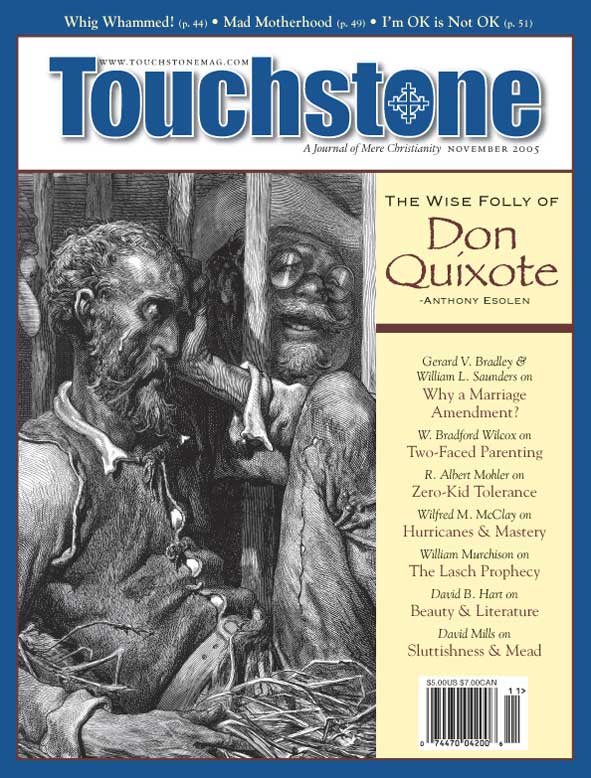Bans of Matrimony
A Constitutional Amendment Is the Only Way to Protect Marriage
by Gerard V. Bradley & William L. Saunders
The legal revolution in favor of same-sex “marriage” has been uncommonly swift. In the nineteenth century, it took the federal government four decades to effectively prohibit polygamy in Utah. By 1856, one national political party (the Republicans) had a platform plank denouncing polygamy, along with slavery, as a “relic of barbarism,” but decisive action came only with the Supreme Court cases in the 1890s.
Smashing Victory
Starting in 1896, it took civil rights lawyers nearly sixty years to undo the constitutional doctrine of “separate but equal” facilities for African-Americans, the doctrine established in Plessy v. Ferguson in 1896 and not overturned until Brown v. Board of Education in 1954 (a decision that featured so prominently in the Senate hearings on the nomination of John Roberts to be Chief Justice). It took thirteen more years, from 1954 to the Loving v. Virginia decision in 1967, to persuade the Supreme Court that putting people in jail for marrying someone of a different color was unconstitutional.
In less time than that, lawyers for homosexuals have taken same-sex “marriage” from an exotic suggestion to a smashing victory in the Massachusetts case Goodridge v. Department of Health in 2003. The judges there declared that “extending civil marriage to same-sex couples reinforces the importance of marriage to individuals and communities” (emphasis supplied).
The Massachusetts decision could scarcely have been more radical. Not only did it cast aside the wisdom of the ages; it declared that our perennial understanding of marriage as the union of man and woman was irrational—in other words, utterly without a foundation in reason. The court even likened opposition to same-sex “marriage” to the racist prejudice against interracial marriage. The date the court appointed for the first same-sex weddings—May 17, 2004—was fifty years to the day after segregation was forbidden in Brown v. Board of Education.
The only real remaining question is how long it will take for same-sex “marriage” to spread from Massachusetts across the rest of the nation. If the history of this revolution is any guide, the answer is that it will not be long— unless the Congress and the people act to put an effective legal block in place.
There are various ways in which same-sex “marriage” might spread across the country. The first is piecemeal: one state at a time, as one state supreme court or perhaps, though this is unlikely, state legislature, establishes the “right.” That is how no-fault divorce laws spread during the 1960s. Lawsuits pending in several states make the same claims as those accepted in Goodridge.
The other two ways by which same-sex “marriage” might spread are (1) by migration of couples who demand recognition in the 49 states of their Massachusetts “marriages” or (2) by a Supreme Court opinion declaring that the Constitution requires the recognition of same-sex “marriage.”
On the straightforward question of whether there is a constitutional right to same-sex “marriage,” as well as on the question whether there must be interstate recognition of same-sex “marriage,” the Supreme Court will have the last word. The best way to ensure that the Supreme Court reaches the correct decision(s) is by amending the US Constitution. Similarly, the only way to ensure that state judges and/or legislatures do not provide legal recognition of same-sex “marriage” is by amending the US Constitution, which is the supreme law of the land and displaces inconsistent state laws.
One Bar
One way in which same-sex “marriage” might spread is by homosexual couples who have been “married” in Massachusetts moving to another state and demanding that their Massachusetts “marriage” be recognized there. One possible bar is the Defense of Marriage Act (DOMA). Enacted in 1996, this federal statute establishes that, for all federal purposes (such as tax returns, veterans’ benefits, social security survivors’ benefits, etc.), only one husband and one wife count as spouses.
But DOMA also addresses the travel question. It says that no state “shall be required to give effect” to any act “respecting a relationship between persons of the same sex treated as a marriage under the laws of [any] other state.” The idea is to bolster states that do not want to have same-sex “marriage” forced upon them because “spouses” from other states have moved into the state.
DOMA is an exercise of a very specific Congressional power, related to the “full faith and credit” required by Article IV of the Constitution. (The provision in its entirety reads: “Full faith and credit shall be given in each State to the public acts, records, and judicial proceedings of every other State. And the Congress may, by general laws, prescribe the manner in which such acts, records, and proceedings shall be proved, and the effect thereof.”)
Under our Constitution, each state must to some degree recognize the laws of other states. Congress can prescribe the “effect” given to, for example, a state judgment from Illinois in Ohio, and there are exceptions and limitations to the “extraterritorial” effect of state law, but marriages are entirely portable: Get married in one state, and you will be married in all the rest. People get a new driver’s license and re-register to vote when they move from state to state. But they are not required to get married again. DOMA makes an exception for same-sex “marriages.”
But DOMA does not “reverse” Goodridge. It does nothing to relieve the citizens of Massachusetts of same-sex “marriage,” and would not do so in any other state that adopted same-sex “marriage.” It performs the limited but valuable service of protecting states from involuntary introduction of same-sex “marriage” through interstate portability.
A state saddled by its activist courts with same-sex “marriage”—the Massachusetts situation—would have to look elsewhere for help. That state’s citizens would have to enact a state constitutional amendment correcting the activist decision (this is being attempted in Massachusetts), or pitch in to pass an amendment to the US Constitution, settling the definition of marriage throughout the country once and for all.
DOMA Challenged
There are three reasons to doubt that DOMA will be upheld when challenged in court. Two apply particularly to the question of interstate portability.
First, we simply do not know what difference Congress’s saying that states need not recognize out-of-state marriages makes. There is no precedent for DOMA. Congress has used its power to prescribe the “effects” of state acts, but in all these cases it required states to recognize other states’ acts. DOMA tells states that they do not have to.
Constitutional scholars are divided on DOMA’s constitutionality. Harvard Law School professor Laurence Tribe vehemently denies that DOMA is constitutional because Congress lacks the power to legislate a “categorical exemption” from full faith and credit. Yale law professor Lea Brilmayer testified before a Senate Committee that Congress does have that power. But the full extent of her reassurance was this: “Marriages entered into in one state have never been constitutionally entitled to automatic recognition in other states.”
Even if Brilmayer is correct, all that means is that Massachusetts “marriages” might possibly be denied recognition in other states because the meaning of the constitutional provisions will be decided by the Supreme Court. If it holds that DOMA does not bar the interstate portability of same-sex “marriage,” it will be too late. The issue will have been settled. Homosexual “marriage” can then spread unobstructed across the nation. Thus, it would not be wise to wait.
The second reason to question whether DOMA will be upheld has to do with the standard exception to interstate recognition: a state’s public policy. States are not obliged to recognize an out-of-state marriage contrary to a strong (in-state) public policy. Many people suppose that so long as a state makes clear that marriage is intended to be for a man and a woman, its “public policy” is “strong” enough to enable it to deny legal recognition to Massachusetts’ same-sex “marriages.”
Unfortunately, the simple assertion that traditional marriage is a “strong public policy” does not make it so. After all, courts in Vermont, Massachusetts, Hawaii, and other states have (in varying ways) overturned their marriage laws despite both long-established legal practice and custom defining marriage as reserved to a man and a woman.
The underlying problem in those states and in almost every state is that so many concessions have been made to de facto “gay unions”—adoption, spousal benefits, and other incidents of marriage—that courts readily conclude that the states do not consistently act on any coherent understanding of marriage. The Goodridge court, for example, said that the “gay” wedding aspirants were already treated as “families” capable of being “excellent parents.”
The court asked: If these folks are already families doing an excellent job raising children, why exactly cannot they “marry,” as do other couples who head families with kids? It is not a trivial question.
DOMA Overruled
Let us illustrate how a court might examine the issue. A judge hearing a Massachusetts couple’s challenge to DOMA in, say, Indiana, will ask the state’s attorney to identify the rational basis for limiting marriage to a man and a woman.
The most likely first answer will be: “because marriage is procreative.” In that case, the court will say, “How is it that sterile couples marry, and that there is no noticeable legal difference between how kids born to married couples and kids born to single women are treated under the law?”
The court, hearing no cogent response, will then likely declare: “It is not really the state’s intent to promote marriage because of its link to procreation. That ostensible ground is instead a cover for mere moral disapproval, or simple prejudice, even ‘animus’ of the kind prohibited by the Supreme Court in Romer v. Evans—none of these is a legitimate rational basis.”
The state’s attorney general might advance a second response: “The husband-wife marital home is where the state wishes to have childrearing take place.” The court’s reply could well be: “Then why does the state permit adoption by unmarried individuals, and even by same-sex couples?” And so on.
This is, in fact, the reasoning employed in Goodridge and in Baker v. State, the Vermont civil unions case from 1999. It will be employed in any state that has conceded anything to “gay unions” or “domestic partnerships” or in any way treated homosexual people as if they were married (by granting them the right to adopt children, for example).
In summary, we cannot know how the courts will settle the question of the interstate portability of Massachusetts’ same-sex “marriages.” But everyone agrees that DOMA will be challenged all across the country and that it may well be overturned.
The only way to ensure that states are not forced to accept Massachusetts’ same-sex “marriages” is to establish law so clear—and whose constitutionality is so solid—that even judges disinclined to follow it will have to. DOMA (a federal statute whose “validity” depends upon whether or not it violates the constitution) does not, and cannot, do that. A well-drafted constitutional amendment, however, can.
No State Interest
Like every other law in this country, state or federal, DOMA has to pass basic constitutional tests. Every law must serve a “legitimate” state purpose and “rationally” serve that end. Here is the third reason to doubt DOMA’s legal effectiveness: the Supreme Court’s latest decision on “gay rights.”
In a six-to-three ruling in Lawrence v. Texas, issued in June 2003, the Court struck down a state law against homosexual sodomy. For the first time, it ruled that states may not forbid people to engage in non- or extra-marital sex acts.
The Court did not rely upon the narrow grounds offered by some opponents of the law, i.e., that Texas could outlaw sodomy as long as unmarried heterosexuals as well as homosexuals were covered. The Court directly overruled one of its precedents, the 1986 case of Bowers v. Hardwick, because it “demeans the lives of homosexual persons.” The justices said that the Texas law served no legitimate state interest and lacked any basis in reason.
The Court seemed eager to make a significant statement about constitutional protection for homosexual relationships. The majority of justices did not argue as if the case were simply about “leaving people alone in their bedrooms.” The reason homosexual acts are protected, the Court said, is precisely because such acts may constitute a person’s identity; because sexual conduct “can be but one element in a personal bond that is more enduring”; because penalizing sodomitical acts could lead to “discrimination both in the public and the private spheres.”
The Court said that “persons in a homosexual relationship” have the same constitutional liberty to marriage, procreation, and family that “heterosexual persons do.” Lawrence is not about sodomy and privacy. It is about homosexual “bonds” and a state’s obligation to respect them.
No wonder that the dissenting justices said of this reasoning that it would “dismantle the structure of constitutional law” that has kept legal marriage a matter of the bond of a man and a woman. Lawrence is a very forbidding warning that any law against same-sex “marriage”— DOMA included—is unlikely to survive in the Supreme Court. (This is true regardless of the confirmation of John Roberts as Chief Justice. Lawrence was a six-to-three decision, and Roberts is replacing one of the three dissenters. Even when O’Connor’s successor is confirmed, and even if Roberts and that person turn out to be “conservatives” on this issue, that still leaves a majority for the result in Lawrence.)
Only Sure Way
The only sure way to stop the movement toward same-sex “marriage” is by amending the Constitution. Serious proposals to do so are many. They break down into two types, although there are important differences within each type, often having to do with the extent to which the amendment impedes the judicial creation of civil unions (i.e., legally recognized relationships that are, nonetheless, not treated as “marriages”).
One kind addresses only the interstate travel problem. These proposals would tolerate same-sex “marriage” in Massachusetts and in any other state where it arose as a result of legal developments within that state. Each state would decide (for itself alone) what marriage is. The other kind defines marriage solely as the union of a man and a woman, and thus, nothing else could be a legal marriage in the United States.
The major argument for the first kind of amendment is “federalism.” Its advocates argue that in our “federal” system states are, have always been, and should be in charge of marriage.
Rather than straitjacket the whole nation with a single legal template, its advocates argue, states should be allowed to experiment with different legal solutions to social problems. They argue also that problems vary from state to state, and local variations demand different responses. One response might be appropriate for Utah, another for Arizona, and still a third for New Jersey.
The argument for the first kind of amendment misses some obvious facts. First, same-sex couples who are also homosexual activists will simply move from one state (where same-sex “marriage” is permitted) to a second state (where it is not). By living in the second state, these activist couples will create “facts on the ground” that state legislatures may find hard to resist. (“How can Johnny’s same-sex ‘parents’ not be recognized at school events or in the PTA when Suzy’s opposite-sex parents are? It is unfair to the child. Wouldn’t it be better to recognize as marriage the relationship that already exists between Johnny’s ‘parents’?”)
Second, there already is a national definition of marriage: Everywhere in the United States, no one may submit to the Internal Revenue Service a form 1040 as “married, filing jointly” except a male husband and a female wife. We still have one definition at the state level, too, with, at the moment, a single exception.
But Lawrence already signals that we will soon have a single national definition of marriage, and it will be a new one: Every state will have to recognize same-sex couples as “married.” As Judge Robert Bork noted in The Wall Street Journal, “One way or another, federalism is going to be overridden. The only question is whether the general rule will permit or prohibit marriage of same-sex couples.”
Indeed, marriage is not simply a matter for the states, and has not been for more than a generation. The strongest statement that marriage is a matter of state law was made in an 1878 Supreme Court case called Pennoyer v. Neff: A state has an “absolute” right to decide the “conditions upon which the marriage relation shall be created.” (Even in this case, the Court did not say the state has the right to decide what marriage is.) By 1971, the Supreme Court found (in Boddie v. Connecticut) the state’s power to be much less “absolute”: States controlled marriage “absent some specific federal constitutional or statutory provision” (emphasis added).
False Analogy
Before considering the defining features of marriage, and because same-sex “marriage” proponents usually rely on this purported analogy, we will examine a special case of national intervention in marriage. In 1967, in Loving v. Virginia, the Supreme Court held that states could not ban interracial marriage. The language of the case, as well as constitutional logic, extends the ruling to prohibit ethnic, national, and color barriers to marriage. Loving means that these characteristics have nothing to do with the definition of marriage and that no state can act as if they do.
The Massachusetts court in Goodridge fundamentally misunderstood Loving. As we noted, the judges likened opposition to same-sex “marriage” to the racist prejudice against interracial marriage. They said in their ruling: “Recognizing the right of an individual to marry a person of the same sex will not diminish the value or the dignity of opposite sex marriage, any more than recognizing the right of an individual to marry a person of a different race devalues the marriage of a person who marries someone of her own race.”
This is a distinction based on a fundamentally flawed analogy. One’s race (or ethnicity or national origin or color) is irrelevant to whether one possesses the characteristics (being a man or a woman) necessary to enter into marriage, while one’s sex is obviously relevant. The Goodridge decision thus underlines the necessity of an amendment to the Constitution before other courts issue similarly misguided rulings.
Let us examine the defining features of marriage and the extent to which states have authority over them. Traditionally, marriage has been held in law to be: (1) monogamous; (2) sexually exclusive; (3) the morally legitimate context for raising children; and (4) permanent. What is the autonomy of the states with regard to each of these?
Monogamy was imposed upon Mormon-controlled territories by the national government toward the end of the nineteenth century, in the course of the protracted struggle over polygamy. While it may be true that a state could, at least theoretically, recognize plural marriages (no Supreme Court case squarely holds otherwise), no one has a right, even on the basis of sincere religious belief, to enter a polygamous marriage.
That is the certain effect of the late nineteenth century polygamy cases decided by the Supreme Court. But if, as the Supreme Court held in Lawrence, one’s sexual acts make up a crucial part of one’s identity, why can’t two men marry? And if two men can marry, why not three, if they feel group sex crucial to their identity? Or more? Why not a group of men and women? If the Supreme Court decides to follow the logic of its Lawrence decision, states would be powerless to limit marriage to couples—of any sort.
The sexual exclusivity of marriage as the only morally legitimate context in which to have and raise children is the central presupposition of many Supreme Court cases. Among them is the Court’s condemnation (in 1942) of an Oklahoma law that punished certain career criminals with sterilization, in which it referred to “marriage and procreation” as “one of the basic civil rights of man.”
Before Lawrence, the states had protected marriage through laws against non- and extra-marital sex of any sort, heterosexual as well as homosexual. This protective mantle originally included laws about illegitimacy designed to limit procreation to married couples. The two types of laws are mutually reinforcing: Limit sex to marriage and increase the chances that kids will be born to married couples; discourage procreation outside of marriage and discourage non-marital intercourse, too.
The Law Changed
But again, the national government changed the law. In the first wave of disruption, the Supreme Court ruled that most legal distinctions based upon illegitimacy are unconstitutional. The seminal case was Levy v. Louisiana in 1968. The laws challenged were justified by Louisiana as attempts to make marriage the basis of family relationships. The Court’s reasoning is opaque, but the main idea seems to have been that these burdens had no social value at all.
The Court stated that the illegitimate person “certainly is subject to all the responsibilities of a citizen, including the payment of taxes and conscription under the Selective Service Act. How under our constitutional regime can he be denied correlative rights which other citizens enjoy?” In support it cited King Lear: “Why bastard, wherefore base? When my dimensions are as well compact, my mind as generous, and my shape as true, as honest madam’s issue? Why brand they us with base? With baseness? Bastardy? Base, base?”
Finally, although the permanency of marriage had long been assumed in American law, the principle of no-fault divorce is in place all across the country, with minor variations between states, because the states chose it. The homogeneous pattern is not the result of an overriding Supreme Court decision. No High Court decision or controlling federal law says that such divorce law is a national rule.
Nonetheless, the extraordinary statements in the Lawrence decision about the individual’s right to express himself sexually without state interference or disapproval strongly suggest that federal constitutional doctrine now blocks any return to fault-based divorce by a state legislature. In other words, no-fault divorce arose without the Constitution, but it may be sustained by the Constitution (as interpreted by the current Supreme Court). To this extent, the non-permanency of marriage is, like all the other defining features of marriage, a national principle an individual state cannot change.
The fundamental objection to the first kind of amendment, that addresses only the interstate travel problem, for those who want to defend marriage, is that the question we face is whether men can marry men and women can marry women. The common justifications for federalism do not apply to marriage. Nothing peculiar to New York or to Wyoming makes any difference.
The common good requires everywhere a single answer to whether a person can marry another, or several others, of the same sex, and that answer is no. Marriage is (though we cannot make the argument here, but see citations at the end) a social institution with an inherent meaning. Thus, only the second kind of amendment, the kind that defines marriage as the union of a man and a woman, will adequately protect marriage in the United States.
Saving Marriage
Today, for better or worse, the national government, principally the courts, have mostly taken the power to define marriage out of the states’ hands, as discussed above. The Supreme Court’s promissory note in Lawrence v. Texas—that it will require same-sex “marriage” as part of everyone’s liberty to express himself sexually, without suffering discrimination—signals the final stage of this takeover.
To save marriage, that is, to ensure marriage remains reserved to one man and one woman, it is necessary to amend the US Constitution. If the Constitution is not amended, it is almost certain that marriage will be fundamentally transformed through the judicial recognition of same-sex “marriage.”
It could happen in either of two ways. First, homosexuals from other states who marry in Massachusetts will return to their home state and demand through legal action that their Massachusetts “marriage” be recognized despite DOMA (under the Full Faith and Credit Clause) and the Supreme Court will agree. As we have seen, the traditional bar under the Full Faith and Credit Clause—that it would, in a particular case, violate the public policy of the second state—seems no longer viable.
Second, the rationale of the Lawrence decision that sexual acts are fundamental to a person’s identity could lead the Supreme Court to hold that the Constitution itself requires the recognition of same-sex “marriage.” (The Court would do so by holding that the language of the Fifth and Fourteenth Amendments—“nor shall any State deprive any person of life, liberty, or property, without due process of law”—creates a substantive “liberty” interest to marry someone of the same sex.)
Thus, it is all but certain the Supreme Court will legalize, nationally, same-sex “marriage.” The Defense of Marriage Act (DOMA) cannot prevent it. It is a federal statute subject to judicial interpretation, which interpretation will be informed by the language of Lawrence about the fundamental importance of sexual behavior. Thus, DOMA is sure to fall, either under the Full Faith and Credit Clause or under a substantive due process “liberty” interest.
It is hardly conceivable that the Supreme Court will allow a federal statute to bar people from exercising such a “fundamental right.” The only way to prevent this is to amend the Constitution.
For an explanation of why marriage is a social institution with an inherent meaning, see John Finnis’s “The Good of Marriage and the Morality of Sexual Relations” and Patrick Lee and Robert P. George’s “What Sex Can Be: Self-Alienation, Illusion, or One-Flesh Union,” both from the American Journal of Jurisprudence (vol. 42, 1997); and Robert P. George and Gerard V. Bradley’s “Marriage and the Liberal Imagination” in the Georgetown Law Journal (84, 1995).
|
Gerard V. Bradley is professor of law at the University of Notre Dame
Law School and until recently president of the Fellowship of Catholic Scholars
(www.catholicscholars.org). His
most recent book is A Student’s Guide
to Law (ISI Books). He and his wife have eight children.
subscription options
Order
Print/Online Subscription

Get six issues (one year) of Touchstone PLUS full online access including pdf downloads for only $39.95. That's only $3.34 per month!
Order
Online Only
Subscription

Get a one-year full-access subscription to the Touchstone online archives for only $19.95. That's only $1.66 per month!
bulk subscriptions
Order Touchstone subscriptions in bulk and save $10 per sub! Each subscription includes 6 issues of Touchstone plus full online access to touchstonemag.com—including archives, videos, and pdf downloads of recent issues for only $29.95 each! Great for churches or study groups.
Transactions will be processed on a secure server.
more on marriage from the online archives
more from the online archives
calling all readers
Please Donate
"There are magazines worth reading but few worth saving . . . Touchstone is just such a magazine."
—Alice von Hildebrand
"Here we do not concede one square millimeter of territory to falsehood, folly, contemporary sentimentality, or fashion. We speak the truth, and let God be our judge. . . . Touchstone is the one committedly Christian conservative journal."
—Anthony Esolen, Touchstone senior editor












